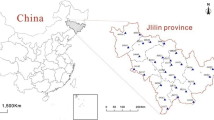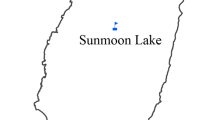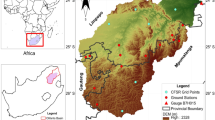Abstract
This study addresses the application of signal processing in the evaluation of meteorological drought associated with monthly precipitation time series. Several drought indices and a Haar wavelet decomposition (WD) with ten components are implemented in the evaluation of the monthly precipitation of a mountainous region called Mount Uludag in Turkey. Monthly precipitation time series in three meteorological stations at the summit and foothills are used. The Standardized Precipitation Index (SPI) is used at monthly, annual, and 12- and 48-month moving average time frames as the benchmark to investigate the drought patterns. The results obtained by the WD and SPI are then confirmed using the Z-score index (ZSI) at monthly and annual scales, together with the modified China Z-index (MCZI) and rainfall anomaly index (RAI) at a monthly scale. Changes in the moments of the distribution, correlation analysis, mutual information, and power spectrum are applied to investigate the nature of the relationship between the sequences of precipitation events in time and space. The temporal correlation analysis, together with the mutual information, showed that the system has a short-term memory with strong seasonality. Similarly, the power spectra depicted major seasonality at 1, 3, 5, 6, 12, 22, and 60 months in the precipitation time series. It is concluded that the recent drought events have an infrequent nature, which altered the sinusoidal patterns of the large-scale events. The SPI-48 and the WD showed that declines are strongly related to the large-scale cycles, but the decline patterns are more related to the station located at the mountain summit.







Similar content being viewed by others
References
Abramowitz, M., & Stegun, I. A. (Eds.). (1970). Handbook of mathematical functions with formulas, graphs, and mathematical tables. (Vol. 55)US Government Printing Office.
Afshar, M. H., Sorman, A. U., Tosunoglu, F., Bulut, B., Yilmaz, M. T., & Mehr, A. D. (2020). Climate change impact assessment on mild and extreme drought events using copulas over Ankara, Turkey. Theoretical and Applied Climatology, 26(2), 254–268
AgriMetSoft. (2017). Meteorological drought monitor (Version 1) [Computer software]. https://agrimetsoft.com/MDM.aspx. Accessed September 2019
Aladaileh, H., Al Qinna, M., Karoly, B., Al-Karablieh, E., & Rakonczai, J. (2019). An investigation into the spatial and temporal variability of the meteorological drought in Jordan. Climate, 7(6), 82
Azmi, M., Rüdiger, C., & Walker, J. P. (2016). A data fusion-based drought index. Water Resources Research, 52(3), 2222–2239
Bahrami, M., Bazrkar, S., & Zarei, A. R. (2019). Modeling, prediction and trend assessment of drought in Iran using standardized precipitation index. Journal of Water and Climate Change, 10(1), 181–196
Bhalme, H. N., & Mooley, D. A. (1980). Large-scale droughts/floods and monsoon circulation. Monthly Weather Review, 108(8), 1197–1211
Caloiero, T., & Veltri, S. (2019). Drought assessment in the Sardinia Region (Italy) during 1922–2011 using the standardized precipitation index. Pure and Applied Geophysics, 176(2), 925–935
Cavus, Y., & Aksoy, H. (2019). Spatial drought characterization for Seyhan River basin in the Mediterranean region of Turkey. Water, 11(7), 1331
Craig, C. A., Allen, M. W., Feng, S., & Spialek, M. L. (2020). Exploring the impact of resident proximity to wildfires in the northern Rocky Mountains: Perceptions of climate change risks, drought, and policy. International Journal of Disaster Risk Reduction, 44, 101420
Du, J., Fang, J., Xu, W., & Shi, P. (2013). Analysis of dry/wet conditions using the standardized precipitation index and its potential usefulness for drought/flood monitoring in Hunan Province, China. Stochastic Environmental Research and Risk Assessment, 27(2), 377–387
Edwards, D. C., & McKee, T. B. (1997). Characteristics of 20th century drought in the United States at multiple time scales: Atmospheric science paper no. 634. (pp. 1–30). Colorado State University.
Eris, E., Cavus, Y., Aksoy, H., Burgan, H. I., Aksu, H., & Boyacioglu, H. (2020). Spatiotemporal analysis of meteorological drought over Kucuk Menderes River Basin in the Aegean Region of Turkey. Theoretical and Applied Climatology, 142(3), 1515–1530
Eslamian, S. (Ed.). (2014). Handbook of engineering hydrology: modeling, climate change, and variability. CRC Press.
Gao, L., & Zhang, Y. (2016). Spatio-temporal variation of hydrological drought under climate change during the period 1960–2013 in the Hexi Corridor, China. Journal of Arid Land, 8(2), 157–171
Gibbs, W. J., & Maher, J. V. (1967). Rainfall deciles as drought indicators. Bureau of Meteorology Bulletin No. 48. Commonwealth of Australia, Melbourne
Gray, R. M. (1990). Entropy and information theory. Springer.
Hansel, S., Schucknecht, A., & Matschullat, J. (2016). The Modified Rainfall Anomaly Index (mRAI)—is this an alternative to the Standardised Precipitation Index (SPI) in evaluating future extreme precipitation characteristics? Theoretical and Applied Climatology, 123(3–4), 827–844
Hao, Z., & Singh, V. P. (2015). Drought characterization from a multivariate perspective: A review. Journal of Hydrology, 527, 668–678
Hao, Z., Hao, F., Singh, V. P., Ouyang, W., Zhang, X., & Zhang, S. (2020). A joint extreme index for compound droughts and hot extremes. Theoretical and Applied Climatology, 142(1), 321–328
Hao, X., Ma, H., Hua, D., Qin, J., & Zhang, Y. (2019). Response of ecosystem water use efficiency to climate change in the Tianshan Mountains, Central Asia. Environmental monitoring and assessment, 191(9), 561
Jasim, A. I., & Awchi, T. A. (2020). Regional meteorological drought assessment in Iraq. Arabian Journal of Geosciences, 13(7), 1–16
Ju, X. S., Yang, X. W., Chen, L. J., & Wang, Y. M. (1997). Research on determination of indices and division of regional flood/drought grades in China. Quarterly Journal of Applied Meteorology, 8(1), 26–33 In Chinese.
Kashyap, R. L., & Rao, A. R. (1976). Dynamic stochastic models from empirical data. Academic Press.
Katip, A. (2018). Meteorological drought analysis using artificial neural networks for Bursa City, Turkey. Applied Ecology and Environmental Research, 16(3), 3315–3332
Li, L., She, D., Zheng, H., Lin, P., & Yang, Z. L. (2020). Elucidating diverse drought characteristics from two meteorological drought indices (SPI and SPEI) in China. Journal of Hydrometeorology, 21(7), 1513–1530
McKee, T. B., Doesken, N. J., & Kleist, J. (1995). Drought monitoring with multiple-time scales. In: Preprints ninth conference on applied climatology. American Meteorological Society, Boston, pp. 233–236.
Mehdizadeh, S., Ahmadi, F., Mehr, A. D., & Safari, M. J. S. (2020). Drought modeling using classic time series and hybrid wavelet-gene expression programming models. Journal of Hydrology, 587, 125017
Mehr, A. S., Safari, M. J. S., & Nourani, V. (2021). Wavelet packet-genetic programming: a new model for meteorological drought hindcasting. Teknik Dergi. https://doi.org/10.18400/tekderg.605453
Meyer, Y. (1992). Wavelets and operators. Cambridge University Press. ISBN 0-521-42000-8.
Mohammadi, B., Vaheddoost, B., & Mehr, A. D. (2020). A spatiotemporal teleconnection study between Peruvian precipitation and oceanic oscillations. Quaternary International. https://doi.org/10.1016/j.quaint.2020.09.042
Mohammed, S., Alsafadi, K., Al-Awadhi, T., Sherief, Y., Harsanyie, E., & El Kenawy, A. M. (2020). Space and time variability of meteorological drought in Syria. Acta Geophysica, 68(6), 1877–1898
World Meteorological Organization (WMO) (2011). Proceedings of an expert meeting. 2–4 June, 2010, Murcia, Spain.
Mutti, P. R., de Abreu, L. P., de Andrade, M. B. L., Spyrides, M. H. C., Lima, K. C., de Oliveira, C. P., Dubreuil, V., & Bezerra, B. G. (2020). A detailed framework for the characterization of rainfall climatology in semiarid watersheds. Theoretical and Applied Climatology, 139(1), 109–125
Ozturk, M. (2010). Uludağ (Zirve) ve Bursa Meteoroloji İstasyonlarının Karşılaştırmalı İklimi. Türk Coğrafya Dergisi, 55, 13–24 (in Turkish).
Rader, C., & Brenner, N. (1976). A new principle for fast Fourier transformation. IEEE Transactions on Acoustics, Speech, and Signal Processing, 24(3), 264–266
Rashid, M. M., & Beecham, S. (2019). Development of a non-stationary Standardized Precipitation Index and its application to a South Australian climate. Science of the Total Environment, 657, 882–892
Salas, J. D., Delleur, V., Yevjevich, V., & Lane, W. L. (1980). Applied modeling of hydrologic time series. Water Resources Publication.
Sen, Z. (2013). Square diagonal trend test procedure. In: 6th international perspective on water resources and the environment, January, 07-09. Izmir, Turkey
Sen, B., Topcu, S., Türkeş, M., Sen, B., & Warner, J. F. (2012). Projecting climate change, drought conditions and crop productivity in Turkey. Climate Research, 52, 175–191
Sepulcre-Canto, G., Horion, S. M. A. F., Singleton, A., Carrao, H., & Vogt, J. (2012). Development of a combined drought indicator to detect agricultural drought in Europe. Natural Hazards and Earth System Sciences, 12(11), 3519–3531
Shannon, C. E., & Weaver, W. (1949). The mathematical theory of communication. University of Illinois Press.
Sharafati, A., Nabaei, S., & Shahid, S. (2020). Spatial assessment of meteorological drought features over different climate regions in Iran. International Journal of Climatology, 40(3), 1864–1884
Simisek, O., & Cakmak, B. (2010). Drought analysis for 2007–2008 agricultural year of Turkey. Tekirdağ Ziraat Fakültesi Dergisi, 7(3), 99–109
Sirdas, S., & Sen, Z. (2003). Spatio-temporal drought analysis in the Trakya region, Turkey. Hydrological Sciences Journal, 48(5), 809–820. https://doi.org/10.1623/hysj.48.5.809.51458
Starks, P. J., Steiner, J. L., Neel, J. P., Turner, K. E., Northup, B. K., Gowda, P. H., & Brown, M. A. (2019). Assessment of the Standardized Precipitation and Evaporation Index (SPEI) as a potential management tool for grasslands. Agronomy, 9(5), 235
Sun, C. X., Huang, G. H., Fan, Y., Zhou, X., Lu, C., & Wang, X. Q. (2019). Drought occurring with hot extremes: Changes under future climate change on Loess Plateau, China. Earth’s Future, 7(6), 587–604
Tatli, H. (2015). Downscaling standardized precipitation index via model output statistics. Atmósfera, 28(2), 83–98. https://doi.org/10.1016/S0187-6236(15)30002-3
Turkes, M. (2020). Climate and drought in Turkey. Water resources of Turkey. (pp. 85–125). Springer.
Turkes, M., Telat, K. O. C., & Saris, F. (2007). Türkiye’nin Yağiş Toplami ve Yoğunluğu Dizilerindeki Değişikliklerin ve Eğilimlerin Zamansal ve Alansal Çözümlemesi. Cografi Bilimler Dergisi, 5(1), 57–73 In Turkish.
Vaheddoost, B. (2017). Spatial analysis of large atmospheric oscillations and annual precipitation in Lake Urmia Basin. European Water, 59, 123–129
Vaheddoost, B. (2020b). A comparative determination of the monthly precipitations trends in Bursa, Turkey. Uludağ University Journal of The Faculty of Engineering, 25(1), 153–168
Vaheddoost, B. (2020a). A spatiotemporal classification of the peruvian precipitations between 1990 and 2015. Pure and Applied Geophysics, 177(9), 4509–4520
Vaheddoost, B. (2019). Evaluation of monthly drought using Standardized Precipitation Index in Bursa, Turkey. In: 4th Eurasian conference on civil and environmental engineering (ECOCEE), June 17–18, DoubleTree by Hilton, Istanbul, Turkey.
Van Rooy, M. P. (1965). A Rainfall Anomaly Index independent of time and space. Notos, 14, 43–48
Vicente-Serrano, S. M., Beguería, S., & López-Moreno, J. I. (2010). A multiscalar drought index sensitive to global warming: The standardized precipitation evapotranspiration index. Journal of Climate, 23(7), 1696–1718
Wilhite, D. A., & Glantz, M. H. (1985). Understanding: The drought phenomenon: The role of definitions. Water International, 10(3), 111–120
Willeke, G., Hosking, J. R. M., Wallis, J. R., & Guttman, N. B. (1994). The national drought atlas. Institute for Water Resources Report 94-NDS-4, U.S. Army Corps of Engineers
Wilson, E. B., & Hilferty, M. M. (1931). The distribution of chi-square. Proceedings of the National Academy of Sciences of the United States of America, 17, 684–688
Yihdego, Y., Webb, J., & Vaheddoost, B. (2017). Highlighting the role of groundwater in lake–aquifer interaction to reduce vulnerability and enhance resilience to climate change. Hydrology, 4(1), 10
Yihdego, Y., Vaheddoost, B., & Al-Weshah, R. A. (2019). Drought indices and indicators revisited. Arabian Journal of Geosciences, 12(3), 69
Yilmaz, E. (2018). Türkiye’de aylık yağış eğilimleri, yağış kaymaları ve yağış Eğilim Rejimleri (1971–2010) (monthly precipitation trends, precipitation temporal shifts and precipitation trends regimes in Turkey (1971–2010)). Journal of Human Sciences, 15(4), 2066–2091. https://doi.org/10.2139/ssrn.3419380
Zhou, J., Li, Q., Wang, L., Lei, L., Huang, M., Xiang, J., Feng, W., Zhao, Y., Xue, D., Liu, C., Wei, W., & Zhu, G. (2019). Impact of climate change and land-use on the propagation from meteorological drought to hydrological drought in the eastern Qilian Mountains. Water, 11(8), 1602
Zhu, G. F., Yang, L., Qin, D. H., Tong, H. L., Liu, Y. F., & Li, J. F. (2016). Spatial and temporal variation of drought index in a typical steep alpine terrain in Hengduan Mountains. Journal of Mountain Science, 13(7), 1186–1199
Author information
Authors and Affiliations
Corresponding author
Ethics declarations
Conflict of interest
The authors declare that they have no conflict of interest.
Additional information
Publisher's Note
Springer Nature remains neutral with regard to jurisdictional claims in published maps and institutional affiliations.
Rights and permissions
About this article
Cite this article
Vaheddoost, B., Safari, M.J.S. Application of Signal Processing in Tracking Meteorological Drought in a Mountainous Region. Pure Appl. Geophys. 178, 1943–1957 (2021). https://doi.org/10.1007/s00024-021-02737-8
Received:
Revised:
Accepted:
Published:
Issue Date:
DOI: https://doi.org/10.1007/s00024-021-02737-8




